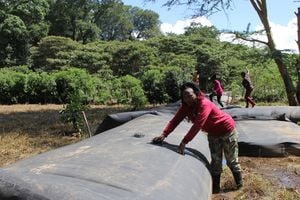When the body temperature hits the roof

Malignant hyperthermia is an extremely rare genetic condition, whose symptoms are triggered by anaesthetic medication, hyperthyroidism, excessive heat and exercise.
What you need to know:
- Malignant hyperthermia is an extremely rare genetic condition, whose symptoms are triggered by anaesthetic medication, hyperthyroidism, excessive heat and exercise.
- A person is born with an abnormal gene that gives rise to inappropriately excessive production of calcium ions in the muscle fibre cells.
Danson* was wheeled into the operating room looking rather cheerful for his situation. He was moved onto the operating table and proceeded to exchange high fives with the anaesthesiologist before going under anaesthesia.
Danson was a healthy 17-year-old high school student who had sustained a fracture of the left femur (thigh bone), in a freak accident during a soccer match in an inter-school tournament. He was brought to the hospital three days ago in intense pain, with his thigh in an abnormal position.
As luck would have it, Danson was a beneficiary of an on-going donor-funded programme that provided expensive metal implants for people with fractures. Instead of spending months staring at the ceiling with the leg trussed up on pulleys, Danson would undergo surgery, have the implant inserted and he would be home in two weeks on crutches bragging to his peers about his “rite of passage”.
The operating room was live with pre-operative procedures in readiness for the two-hour surgery. The surgeon and his assistants were scrubbing while the scrub nurse set out her surgical tray. As a fifth year student rotating in anaesthesia, my attention was with the anaesthesiologist as he drew and labelled various medications for the procedure, all the while explaining what each of them was intended for. Danson was quite intrigued.
It was time for Danson to go to sleep. He opted to count down from 10 as I pushed in the medication through his intravenous line; and managed to get to four before he sank into unconsciousness. The anaesthesiologist then pushed in the muscle relaxant and a minute later, Danson was intubated and the anaesthetic gases mixed with oxygen went through the respirator to his body to keep him asleep, unaware and relaxed.
However, the monitors Danson was hooked onto started going bonkers. Alarms were going hysterical as his vital signs started to misbehave. Instead of his muscles being relaxed, Danson went all stiff as the muscles contracted abnormally. His body was using up too much oxygen and carbon dioxide was piling up in his circulation. The heart rate was precipitously high and suddenly he was burning hot!
The quick-thinking anaesthesiologist recognised the rare but potentially life-threatening medical complications that Danson was manifesting right before our eyes! I was pulled out of my frozen panic by a call for help as the anaesthesiologist took charge of the emergency response. He asked for medications in rapid succession, administering the antidote required to save Danson’s life and other medications to stabilise him.
The room was flooded with other anaesthesiologists and as students, we took a step back, watching the action from a corner out of everyone’s way. At this point, Danson was being swathed with frozen ice packs to cool his body. Multiple blood and urine specimens were taken to the lab and their results expedited.
It took about three hours for Danson’s condition to settle down enough for the team to let out a sigh of relief. He was transferred to the temporary intensive care unit with a diagnosis of malignant hyperthermia. It was time to explain to his extremely anxious parents what had transpired. One minute their healthy bubbly son was waving at them as he went in for a straight-forward, though major surgery, the next minute, he was lying there covered in tubes, having survived a hurricane. It would take a few days of close observation to determine if Danson had survived the worst of it, top on the list being multiple organ failure. Danson was a fighter.
His kidneys held strong, as did his blood clotting factors. He got mild brain swelling but it did not last long.
Those of us who had been in the operating room when it happened watched him like a hawk, checking on his lab reports and vital signs to ensure he was really surviving this. Danson did not let us down. He woke up really pissed that his bone was still broken and he was going to have to stay with us for three more months. He did not comprehend how close he came to leaving us.
Malignant hyperthermia is an extremely rare genetic condition, whose symptoms are triggered by anaesthetic medication, hyperthyroidism, excessive heat and exercise. A person is born with an abnormal gene that gives rise to inappropriately excessive production of calcium ions in the muscle fibre cells.
Calcium ions are chemical agents responsible for making the muscle fibres contract. Therefore, in excessive amounts, they overstimulate this process, initiating a cascade of events that if not halted, will lead to injury of body organs and eventual death. Symptoms start to show soon after exposure to anaesthesia, but may delay and start to manifests even after surgery, during the recovery phase. These include muscle spasms, increased heart rate, rising body temperatures as high as even 440C, literally cooking one from the inside.
It is thought that this condition may be as common as 1 in 10,000 persons but since not every person will be exposed to triggers in their life course, they will survive a lifetime with no manifestation of the symptoms. Hence, documented cases are as low as 1 in 50,000 to 1 in 100,000 persons. Unless one is genetically screened for it, they don’t know that they carry the defective gene until it is triggered such as in Danson’s case. This can easily result in anaesthetic death on the operating table.
Danson lost time in school but he managed to resume class after five months. He lost the school year but resumed with a new determination to become a doctor!
Dr Bosire is an obstetrician/gynaecologist





